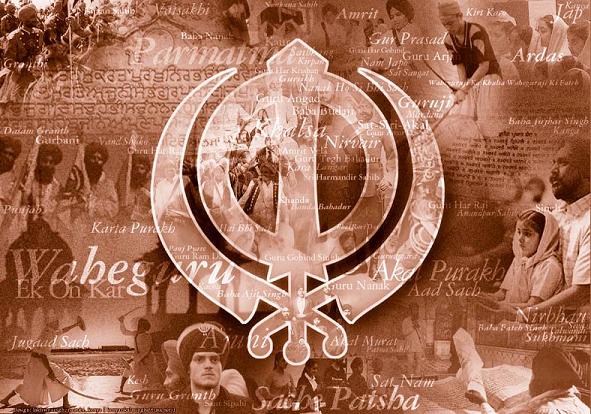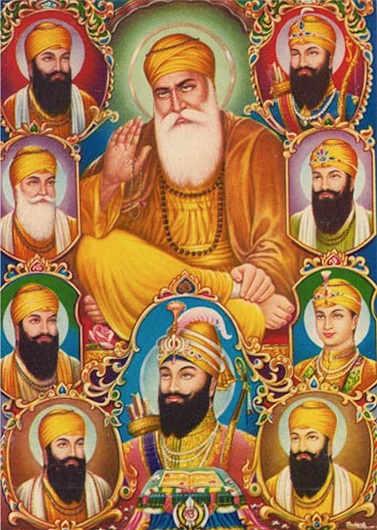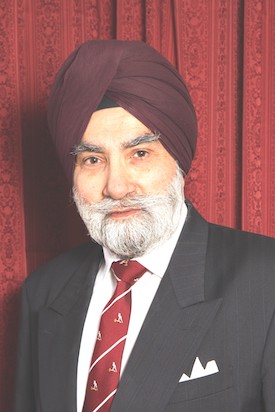Life and Teachings Of Guru Gobind Singh
“Faced with threats from outside and dissension within the Sikh Panth, Guru Gobind Singh thought long and deeply about his own position as the successor of Guru Nanak.” (Dr J S Grewal, The Sikhs of Punjab, Cambridge University Press 1995, p 76
Guru Gobind Singh was a spiritual and temporal leader, poet, saint-warrior, nation-builder and a living martyr who sacrificed his family for his beloved Khalsa and for the freedom of the ordinary people. He called himself the humble servant of the Supreme Being and gave all credit to his Khalsa, the Army of the Timeless Being.
However, the incredible achievements of Guru Gobind Singh become clearer when seen as part of the Guru Jot-Jugat continuity process from Guru Nanak Sahib to Guru Granth Sahib. Guru Gobind Singh was the successor of Guru Nanak. Panthic unity and progress today, depends on the understanding and acceptance of that succession process. For example, Guru Nanak-Gobind Singh mission included nation-building from Kartarpur onwards. That objective too continues to be work-in-progress for the Khalsa Panth.
Through his own life, the Guru taught that the human life is like a fantastic play, it is the Bachittar Natak which has to be participated in. Opting out of world-play is not an option for a Sikh because all is in the Hukam of Akal Purakh and all that happens is in His Bhana (Divine Will) which must be willingly, nay gratefully, accepted and abided by. Remaining in Chardhi Kalaa or positive God-centred ascending spirit while facing all challenges in life, is Guru Gobind Singh’s main lesson for living a full life no matter what the individual circumstances. He taught and led by own example.
As a living-martyr, he witnessed the martyrdoms of his parents, Guru Tegh Bahadur at Delhi and Mata Gujri at Sirhind; the martyrdoms of his four Sahibzaaday at Sirhind and Chamkaur; and, finally, when the time came, he gave his own life at Nanded (Hajoor Sahib). He chose to tread barefooted through the thorny forests of Macchiwara instead of living a royal life at Anandpur. He gave his all for his beloved Khalsa and for the liberation of the people of the Indian sub-continent.
Guru Gobind Singh’s remarkable life-journey from Patna to Hazoor Sahib
Gobind Das, also known as Gobind Rai before Vaisakhi 1699, was the only child of Ninth Nanak, Guru Tegh Bahadur and Mata Gujri. He was born at Patna in Bihar, on 18 December 1661 (see end-note about the date). Many prominent Hindus and Muslims, including saints and nobles, became devoted to him from his childhood. He loved all and was loved by all. However, he confronted evil in whatever religious, social or political guise.
He was aware of the preaching tours of his father-Guru Tegh Bahadur to distant places to revive the Sangats of Guru Nanak. From the age of nine years, he accompanied his father during the Panjab and Bangar Desh tours. At the age of 14 years he was fully aware of the plight of the Brahmins of northern India and Kashmir when they came to seek Guru Tegh Bahadur’s help against Aurungzeb’s religious persecution. Gobind Rai played a key role in Guru Tegh Bahadur’s decision to confront Aurungzeb with his cruelty. Guru Tegh Bahadur’s subsequent unique martyrdom would awaken the people of India to resist foreign invasions and state terrorism under the lead of the Guru’s Khalsa.
That was the position of strength which the Guru inherited from Guru Nanak to Guru Tegh Bahadur. The foundation on which Khalsa institutions were built by a succession of Guru-persons was laid deep by Guru Nanak. Now the Guru Jot-Jugat resided in him to complete the Guru tuition period from 1469 to 1708.
Gobind Rai was anointed Guru on 8 July 1675 before Guru Tegh Bahadur set off for Delhi to confront Aurungzeb with his religious zealotry. His own evidence leaves no doubt that Aurungzeb was in Delhi when the Guru Tegh Bahadur and his three Sikhs, Matti Das, Bhai Dyala and Satti Das. were martyred.
He fought 14 battles between 1688 (Battle of Bhangani) and 1705 (Battle of Muktsar) against impossible odds: the combined forces of the tyrannical Mughal rulers and their cowardly subordinate rajas and vassals. The epic battles of Anandpur and Chamkaur are memorable in the history of warfare.
In accordance with Guru Nanak’s pre-condition for treading the path of Sikhi (Je tao prem khelan ka chao), as Tenth Nanak, he put his Khalsa through the mar-jeevra (reborn) Amrit initiation test on the Vaisakhi Day in 1699. He taught them the Nash doctrine to ensure complete break from the divisive ways of the wily Brahmin which had enslaved the ordinary people of the Indian subcontinent for centuries.
After some years at Paonta, where literature was written and collated to awaken the dormant spirit of the people, followed the battle of Bhangani forced on the Guru by the treacherous hill rajas. The Guru moved back to Anandpur for the next phase. Time had come to take up the sword as the last resort to oppose oppression and foreign invasions.
After Vaisakhi 1699, events took place in quick succession. With reports reaching the Mughal Darbar, came the confrontation. The siege of Anandpur; the epic battle of Chamkaur and the martyrdom of the two older Sahibzaaday; on to Macchiwara through thorny bushes from Chamkaur, alone barefooted with a sword in hand; the martyrdom of the two younger Sahibzaaday as ordered by the Nawab of Sirhind; the remarkable journey in disguise as Uch-da-Pir; the regrouping of the Khalsa army around the Guru to deliver a crushing blow to the pursuing Mughal forces at the last battle of Muktsar and on to Nanded (Hajoor Sahib) after some months stay at Damdama Sahib.
In the succession battles for the throne after Aurungzeb, prince Muazzam, the most moderate of his sons, sought the Guru’s help through the mediation of the Guru’s devotee scholar, Bhai Nand Lal. Help was given and appreciated; but once he became emperor as Bahadur Shah, probably due to pressure from the religious fanatics around him and his weak position as a new emperor, he reneged on his promise to punish the powerful Nawab of Sirhind who had ordered the martyrdom of the younger Sahibzaaday. He was probably implicated in the treacherous stabbing of the Guru while resting. The assassin himself was killed by the Guru.
As pre-ordained, the teaching mission of Guru Nanak Jot in ten human forms was nearing completion. Baba Banda Singh Bahadur was given his final instructions. He was to follow the Guru’s own example as the servant-Commander of the Khalsa army and continue with the Guru’s nation-building mission towards a sovereign Khalsa state in which all enjoyed equal freedoms and rights.
Guru Gobind Singh passed on the Gurgaddi to Guru Granth Sahib. And so, having completed own mission as Nanak Tenth, the Guru departed for Sach Khand a on 7 October 1708.
Guru Gobind Singh was a living martyr, a Sarbans Daani, who sacrificed his whole family to accomplish his mission which he stated as:
“For this purpose was I born: To spread righteous living, to raise the saintly people and to destroy the evil doers.” (Guru Gobind Singh, Bachittar Natak)
Pen before the sword
Guru Gobind Singh believed in the power of the pen.
The strategy followed was the same as that of the earlier Gurus starting with Guru Nanak.
He energised a downtrodden people by reminding them of their own heritage by making available to them in common language the Vedic literature (ancient Hindu literature) about the great deeds of their own Indic folk heroes: the mythological gods and goddesses, who (in their belief system) were the forces of good who had fought and destroyed the forces of evil. Encouraged by him, scholars and poets flocked to him to write poetry and literature in the ordinary language of the people. This was a sacrilege for the Brahmin because, hitherto, Vedic literature in Sanskrit had been monopolized and exploited for personal gain by the Brahmin to maintain his social position at the top.
He specifically denounced the Brahmin priestly class, the bipran, who misled and exploited the ordinary people and were the main cause of India’s weak position against the onslaught of Islamic invaders. They were held responsible for the divided Indian society and the subjugation of the people of sub-continent for centuries.
The literature associated with Guru Gobind Singh should be seen in its proper context as above, as a means of awakening the people to their own past which showed the triumph of good over evil. However, he made it clear even in that literature that his own path did not follow the old ways and that he was the servant of none other than the One Supreme Timeless Unborn Creator Being (also described in Jaap Sahib as The Self-Aware Unlimited Energy capable of changing from Potential (Achal) state to manifest state at Own Will.)
Yet, in another sense, the Vedic literature made available in common language exposed the ancient myth and lore to the scrutiny of the more discerning. Many decided to join the expanding ranks of the Guru’s mar-jeevra (reborn) Khalsa. From Guru Nanak Sahib onwards, the Guru Jote (divine Light) warned that Sikhi demanded one’s ego-centric head! Sikhi was a challenging and difficult path of love and sacrifice to follow. A Path of inner detachment while remaining fully participative in the Creator’s world-play. It was about social activism and it unequivocally rejected the opt-out lifestyle of the Indic systems.
Like work-in-progress, we shall continue at our own pedestrian pace to comprehend and analyse the literary contribution of Guru Gobind Singh. In my view, arrogant positions for and against the literary works associated with the Guru, miss the point.
The great challenges faced by the young Guru Gobind Rai belied the underlying strength of his heritage. Spiritually and morally, the Panth of Guru Nanak, now led by Guru Gobind Singh was in a strong position against an empire which was already facing rebellions. The extensive network of Guru Nanak’s sangats had been already been revived by Guru Hargobind and Guru Tegh Bahadur. Physical fitness, marshal arts, swordsmanship and horse-riding had already become an established Sikh tradition.
In the Guru’s trans-caste people’s army, the lowest was equal to the highest. The Khalsa army had sustained supply of men and women warriors from different social backgrounds. Ordinary people sided with and willingly sheltered Sikh freedom fighters. The Mughal power, backed by a vast empire, was overwhelming at first but not sustainable over the decades as revolts broke out. Moderate Muslims too turned against the cruelty of the local nawabs.
Egalitarian Khalsa institutions of langar, sharing, daswandh(13) and sewa (community service) sustained the Khalsa armies fighting the war of independence. They learnt about mutual interdependence as they fought for freedom from the invaders from the north-west.
The circumstances of the well-publicised unique martyrdom of Guru Tegh Bahadur at Delhi for religious freedom, witnessed by the leaders of Islam, Hinduism and other religions and sects had sent a massive shock wave across the Indian subcontinent and beyond. Guru Gobind Rai was well aware of the great impact amongst the masses of his father-Guru’s martyrdom, the unique deed in Kalyug about which he wrote; the deed that had added a new urgency to resist Aurungzeb’s bigotry.
As a response to internal division, Guru Gobind Singh instructed his Khalsa not to associate with certain sects connected with the Guru family. The system of masand intermediaries was abolished. T These steps were necessary for the military discipline and unity of the Khalsa also.
The process of replacing Guru-person with Shabad-Guru (Gurbani) started by Guru Arjan was completed by Guru Gobind Singh. Gurgaddi was passed on to Guru Granth Sahib and the Khalsa Panth was empowered to make decisions as guided by Guru Granth Sahib.
Thus, was revealed the Niara Khalsa by Guru Gobind Singh who himself bowed before his Khalsa as Akal Purakh ki Fauj, the Army of the Timeless One. Truly there never was and never will be another like Guru Gobind Singh, the greatest saint-warrior of all times.
Finally, looking around at the current challenges faced by the Sikh nation, I am reminded of an old editorial by ex-editor of the prestigious journal, The Sikh Review, late Capt Bhag Singh MBE. He concluded his editorial of August 1974 issue of The Sikh Review, with these words:-
“There seems to be deliberate and not so obviously deliberate attempts by influential and powerful people in India today to tame the Singh (lion). Some of these attempts are more dangerous because they do not consist in a frontal attack on Sikhism but in the perversion of its principles and belittling of its achievements.
It is in the true interests of India that the lion [of Guru Gobind Singh] remains untamed……Tempering with this ideology is also a disservice to India. It is the Sikhs’ national duty, therefore, to preserve Sikhism and the Sikh historical tradition from tinkering and extraneous implantations. “
The above advice for the people and politicians of India was true in 1974. It remains highly relevant today.
As for Sikh nation-building, that is an evolutionary process and will continue as work-in-progress.
Note about Guru Gobind Singh’s Parkash (birth) date:
Sikh historiographers have shown beyond doubt that birth dates of some Gurus, starting with Guru Nanak Sahib, are not the same as the dates on which they are celebrated. As confirmed by contemporary sources, Gobind Das was born on Samat 1718 Pokh Massay Sudi Saptmi on Budhwar (Wednesday). Converted to Julian Calendar, that date is 18 December 1661. The day of the week was Wednesday on that date. (Guru Kian Sakhian, Sakhi 18 and Bhatt Vahi Purabi Dakhni).
© Copyright Gurmukh Singh OBE (U.K.)
E-mail: sewauk2005@yahoo.co.uk
Please acknowledge quotations from this article
Articles may be published subject to prior approval by the author


